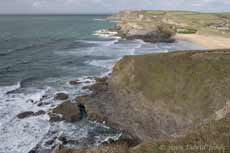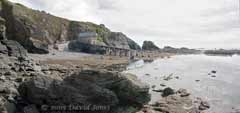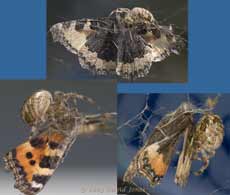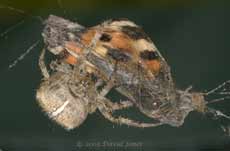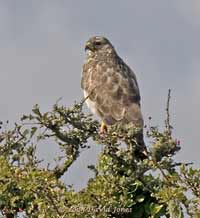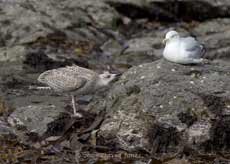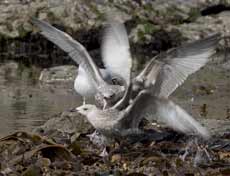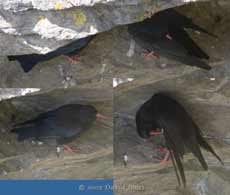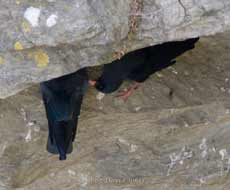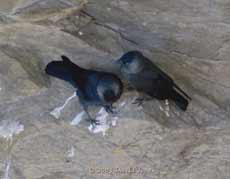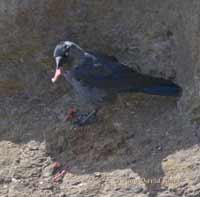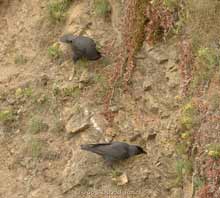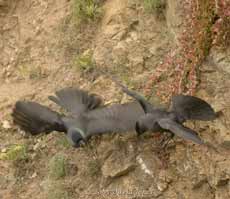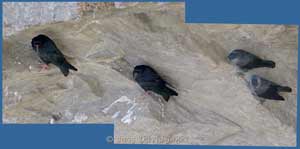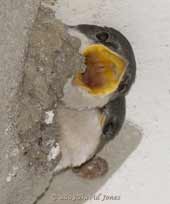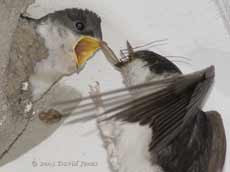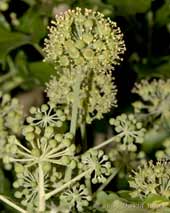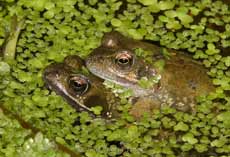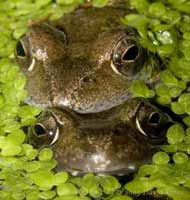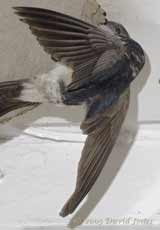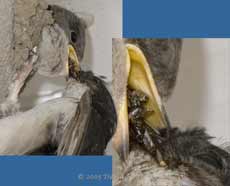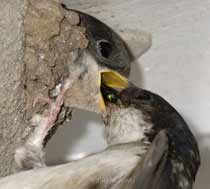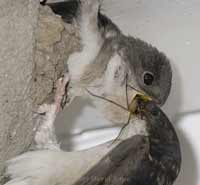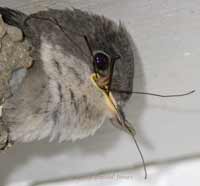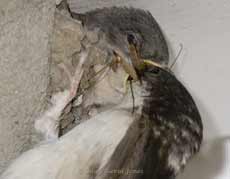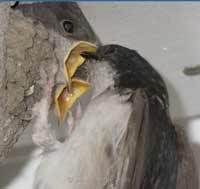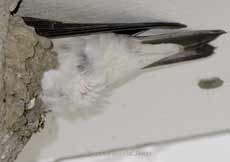Go to the last entry on this page .....Go to previous entry11 - 26 September (written on the 27th)- Another enjoyable couple of weeks down on the Lizard peninsular - the weather was great for most of the time with any rain falling mostly at night.
While there were some decent looking waves on that windy day, we didn't get any rough seas all holiday, which was a shame!
In the large version of this photograph you can see two buildings on top of the cliff, above the lifeboat station. The right-hand one is the Polpeor Cafe where we have spent much time, having a coffee or a meal with just a short hedge (just above table top height) between us and the view.
On the campsite field there were quite a few butterflies, mainly Speckled Woods and Painted Ladies, although I saw a few Small Tortoiseshells, including this unfortunate individual that flew into a web outside our caravan awning.
Then, it worked on wrapping its victim up in silk, using its legs to rotate the butterfly to create a 'package' which it then carried up into a hidden spot.
There must have been a couple of dozen Garden (or Diadem) Spiders (Araneus diadematus)around the outside of the caravan. Those inside the awning made a good living, especially as Sheila hates craneflies! Before we packed up to go home, each spider had to be transferred to spots around the side of the field.
As we drive around the narrow Cornish roads we are always on the lookout for birds of prey, especially Buzzards which we usually spot at a moment when it is impossible to stop, let alone use a camera. However, this time I did get this one chance, although moments after this shot was taken it swooped down on the other side of the high hedge and across a field away from us - If only I had enough time to support the camera properly!
As usual, we spent a great deal of time down at Lizard Point, watching the ships and the birds go by. There were lots of Herring Gulls and Black-backed Gulls (didn't decide which species), and a small group of Oystercatchers. I saw what I think was a juvenile Kittiwake. There were quite a few Cormorants, and I could count six or seven Grey Seals around the rocks that surround the Point. Back in June I photographed some Herring Gull chicks at their nest on the cliff about the cove at Lizard Point. Now, the chicks from that time are flying noisily all around the Point. However, they are still only too ready to pester their parents in the hope of getting some easy feed. The parent in this shot wasn't at all impressed by its offspring's begging!
When a second youngster tries to approach the parent there is an inevitably aggression as one tries to dominate the parent's attention.
Having watched the family back in June, it was disappointing not to see them in the Summer (as they had spread out West along the coast), but in the second week of the holiday I spotted two again, spending time at the cave where they had nested. The absence of rings on their legs indicates that they are adults, very likely the parents. I saw them first on the 20th but didn't take these pictures until lunchtime on the 23rd . It was a very bright, sunny day and they spent time on a ledge hidden in deep shadow, making it difficult for photography. They would spent time there, preening before heading off to feed in fields further round the coast.
Whenever the Choughs left a pair of Jackdaws would take over their spot, only to depart very quickly as soon as the Choughs returned. This is a rather blurred image which I shall blame on the breezy conditions at the clifftop!
There are quite a few resident Jackdaws around Lizard Point. Like the Choughs, they fly back and forth between the cliffs and the fields to forage for food, but they also spend time searching along the cliffs themselves. This one is pecking at something red that
it has just brought to this spot.
This shot reveals one of the targets for the Jackdaws' interest on the cliffs. The bird at the top of the image is pecking at the leaves on a Purple Dewplant. These plants are an invasive species from
South Africa, introduced a century ago and which are rapidly colonizing the
cliffs. Their small flowers look very attractive in Spring, but they are
driving out native species. In the photograph you can see the long 'tendrils'
of the plant as it spreads down the cliff. The plant is a succulent and its bulbous leaves are spongy and full of water, which makes me think that the Jackdaws may be using them a source of fresh water. The photograph also shows the longer leaves of another, related invasive species, the Hottentot Fig which is only just moving into this bit of the cliff. Elsewhere around the Point it has taken over almost completely, again providing a very attractive display in the Spring while smothering native species. It would be virtually impossible to clear either plant from these cliffs, so it looks as though they are here to stay, something that the Jackdaws will not mind as the plants seem to provide them with nesting sites as well as water!
The Jackdaws never stay still for long on the cliffs and soon the pair join the others in a flying display before heading off to the fields again. Sitting at the edge of the cliff, you get a really close view of them and the gulls as they demonstrate their flying skills in the up-draught, sometimes just feet away from you - they make flying look so easy.
As I said before, whenever the Choughs returned to their perch the Jackdaws had to leave, and several times they were also chased out of the cave itself. However, the next picture captures a moment's exception to the usual pattern.
There are a few more holiday images to add and this I hope to do in the next couple of days.
As this picture shows, there are at least two chicks present, and the shot gives you a 'parent's eye view' of the gape. While the chick at the entrance is often chirping away, presumably to attract the parents' attention, there is often a rasping call from behind it as the sibling tries to get its share of the view out. Occasionally both heads disappear and the noise indicates a fierce argument is in progress!
While I watched, my photographs indicated that a fair proportion of the food delivered was in the form of Craneflies.
One last image that gives some detail of the adult as it passes another cranefly to a lucky chick!
28 September - A blustery, cool day with some sunshine, but also dark clouds passing over (not dropping rain during the day). For me it has been one of those weary days. Nevertheless, the lawnmower had some exercise. It's amazing how that can improve the appearance of the garden. Now I need to sort out some of the shrubs and other flowering plants that have given up for the year.
I will be pointing my camera at the Ivy a
lot in the weeks to come as the flowers attract a variety of insects. This
morning, a Red Admiral visited the topmost flowers.
No, I haven't decided to include an 'old' picture! This photograph, taken early this afternoon is not one I would expect to take until February or March. The two frogs have been in this tight embrace since noon (I'm writing this at 6.10pm). I don't expect to see frog spawn as a result of the encounter, but it is an unusual sighting, for me at least. I disturbed them as I cut the grass, but even then they stayed together. While I have watched the House Martins (via cctv) throughout the day I decided not to try photographing them. As I write this one of the chicks is on the look out for the arrival of food. Yesterday, I forgot to mention how switched on the chicks already are to tracking flying insects. Numerous times the chick at the entrance would seem almost mesmerised by the actions of flies that spent time just out of reach, or a spider that moved about on the woodwork just to the left of the nestbox. At 6.30pm I've just seen an adult Martin fly into the adjacent nestbox, so it seems that they are getting ready to roost overnight.
29 September - Another dry day on which I spent several hours watching the Martins again.
Today I decided to try getting closer to the House Martins by mounting the camera at the top of a ladder. I sat on folding chair from the caravan and, using a long remote release, tried to press the shutter at the right moments. I must have taken over a hundred shots but the speed at which feeding takes place meant that the vast majority of the images have to be scrapped. What follows is a selection of cropped images from that session, this first one being the only opportunity to get a reasonable shot of an adult's wings. Notice the deep blue colour of its back feathers.
There is plenty of food about at the moment and there is no competition from other Martins (except for a group of six I saw two days ago but not since). Insects come in various sorts, from small flies (I think there are two in this feed),
to this Bluebottle (or Greenbottle).
However, it was craneflies that provided the largest source of food for the chicks.
That one was gratefully received, leaving the chick to deal with the legs.
This delivery brought two craneflies. Unfortunately I missed the moment that followed as the parent left.
There were only a couple of opportunities to catch an image of both chicks and this was just one of a couple that I caught this afternoon.
Finally, a look at the rear end of one of the chicks. You can see the ring of feathers that surround its cloaca. On the basis that the chicks take between 19-25 days to fledge, I would expect them to leave the nest sometime in the next five days.
I had a surprise bonus while watching the Martins, when a Buzzard flew over the house, quite high up, but unmistakeable. It was flying slowly eastwards and appeared to be searching for thermals. While in Cornwall, we watched one rise very high in a thermal out over the sea in Falmouth Bay, but this one seemed to do just one revolution before moving off to find another area of rising air. Click on the images to see larger versions - |
|
